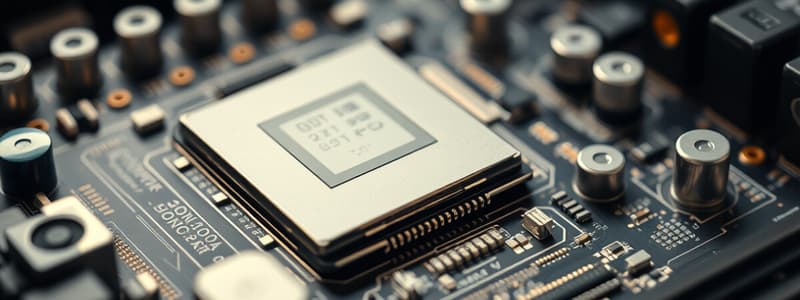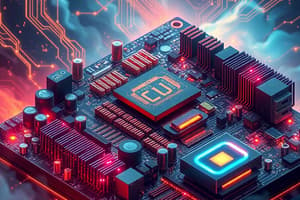Podcast
Questions and Answers
What are the key parts of a motherboard?
What are the key parts of a motherboard?
- Processor socket (correct)
- Memory (correct)
- Processor (correct)
- Network interface
What does CPU stand for?
What does CPU stand for?
Central Processing Unit
Name some major processor manufacturers.
Name some major processor manufacturers.
Intel, AMD, Qualcomm, Apple Inc., NVIDIA, Motorola, VIA, Samsung
How is the speed of a processor measured?
How is the speed of a processor measured?
The register size refers to the number of bits processed at one time, which can be ____ or ____ bits.
The register size refers to the number of bits processed at one time, which can be ____ or ____ bits.
What does a bus do in computing?
What does a bus do in computing?
What is the purpose of the internal data bus?
What is the purpose of the internal data bus?
What is the role of the external data bus?
What is the role of the external data bus?
What is the ALU?
What is the ALU?
What does the clock speed of a processor refer to?
What does the clock speed of a processor refer to?
What is the significance of the front side bus (FSB)?
What is the significance of the front side bus (FSB)?
What type of memory is cache memory?
What type of memory is cache memory?
What does dual-core processor mean?
What does dual-core processor mean?
What is virtualization in computing?
What is virtualization in computing?
Match the following components with their descriptions:
Match the following components with their descriptions:
What is the purpose of a heat sink?
What is the purpose of a heat sink?
Flashcards are hidden until you start studying
Study Notes
Key Parts of Motherboard
- Processor, processor socket, memory, and expansion slots are essential components of a motherboard.
Processor (CPU)
- Central Processing Unit executes instructions, performs calculations, and manages input/output operations.
- Each motherboard has chips designed specifically to work with the CPU.
Major Processor Manufacturers
- Key players include Intel, AMD, Motorola, VIA, Samsung, NVIDIA, Apple Inc., and Qualcomm.
- Intel and AMD dominate the desktop and laptop processor markets.
Speed of a Processor
- Processor speed is measured in gigahertz (GHz), indicating billions of cycles per second.
- The original PC CPU, the 8088, operated at 4.77 MHz; current processors can reach speeds near 5 GHz.
Register Size
- Register size indicates the number of bits processed at once; modern CPUs often have 64 or 128-bit registers.
- Intel's 8086 processor had a register size of 16 bits.
Bus
- Buses are electronic lines that transfer binary data within the processor and to other chips.
- Increasing bus size can improve computer performance, similar to adding lanes on a highway.
Internal Data Bus
- The internal bus comprises lines within the CPU, where the 8086 featured 16 lines.
- Current processors can have 64 or 128 internal data buses operating concurrently.
External Data Bus
- The Front Side Bus (FSB) allows communication between the CPU and external devices such as printers and keyboards.
- Today's processors support 64- and 128-bit external data paths.
Arithmetic Logic Unit (ALU)
- ALU, located in the processor, handles all necessary calculations and logic comparisons.
Pipelines
- Pipelines consist of internal buses working concurrently within the processor.
Clock Speed
- Indicates how fast a processor's internal clock operates, also measured in gigahertz.
Bus Speed
- Refers to the data delivery speed during bus usage on the motherboard.
Front Side Bus (FSB)
- Represents the speed between the CPU and certain motherboard components, usually listed in megatransfers per second (MT/s).
Back Side Bus
- The connection speed between the CPU and L2 cache.
PCI/PCIe Bus Speed
- Reflects the data delivery speed when the PCI bus is in use.
Advanced Graphics Port (AGP)
- Similar to PCI, AGP defines the speed of data delivery to graphics cards, used in older standards.
CPU Speed
- Describes how fast the CPU operates; some motherboards allow for changes to this speed.
CPU Throttling
- Involves reducing the CPU's clock frequency to decrease power consumption and heat, particularly useful for mobile devices.
Cache Memory
- Fast memory type that enhances the speed of processor operations with rapid access.
Types of Cache
- L1 cache is integrated into the CPU, L2 cache is included in the CPU packaging, and L3 cache can be on the CPU die or motherboard.
Clocking
- The motherboard generates a clock signal that manages binary data transfer to/from the processor.
Dual Independent Bus (DIB)
- Utilizes two separate buses: the front side bus (to motherboard components) and the back side bus (to L2 cache).
Multi-Core Processors
- Feature multiple CPUs in a single unit: dual-core (2), tri-core (3), quad-core (4), hexa-core (6), and octa-core (8).
- Modern processors have built-in memory controllers for efficient data handling.
HyperTransport
- A high-speed bus technology that is replacing the front side bus architecture.
Dual-Core Processor
- Combines two CPUs into a single unit for enhanced processing capability.
Tri-Core Processor
- Integrates three processors within one unit.
Graphics Processing Unit (GPU)
- Found either within the CPU or on an adapter card, GPUs handle graphical data processing.
Integrated GPU (iGPU)
- A type of graphics processing integrated into the CPU, allowing for quick data processing without an external GPU.
Virtualization
- Enables running multiple virtual machines on one computer, allowing for multiple operating systems on a single device.
Peripheral Component Interconnect (PCI)
- A now less common expansion slot available in various types.
Heat Sink
- A metal structure with fins used to dissipate heat from the processor or motherboard components.
Studying That Suits You
Use AI to generate personalized quizzes and flashcards to suit your learning preferences.




